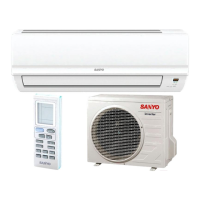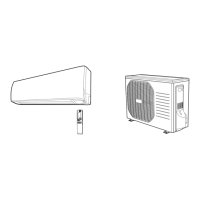Fig. 13
3. Install Indoor Unit
3-1. Install the Rear Panel
(1) Install the rear panel horizontally using a car-
penter’s level or inclinometer. Since the unit
was designed for water drainage to either the
left or right direction, depending on the outlet
side you require provide a slight downward gra-
dient to ensure adequate drainage of the water
pan in the correct direction. (Fig. 11)
(2) Fix the rear panel to the wall using screws
required for the wall type. Use plaster board fas-
teners / toggle bolts for hollow walls.
(3) Be sure to affix the rear panel securely enough to
hold the weight on an adult (at least 60 kg), with
attachment screws spaced to evenly divide the
weight of the unit.
3-2. Install the Tubing Hole
(1) Determine which side of the unit you should make
the hole for tubing and wiring. (Fig. 12)
(2) Make the tubing hole (ø65 mm) in the wall at a
slight downward slant to the outdoor side. (Fig. 13)
Before making the hole, check carefully that no studs
or pipes are directly run behind the spot to be cut.
The above precautions are also applicable if tubing
goes through the wall in any other location.
(3) Insert a PVC pipe in the hole to prevent the con-
nection piping and wiring from being damaged
when passing through the hole.
3-3. Install the Drain Hose
(1) The drain hose must be angled at a downward
slant for smooth, unimpeded drainage.
(2) Supply adequate support for the hose, and do not
pull on it or permit bends or water traps to occur.
The outlet end must not be immersed in water or
otherwise blocked. (Fig. 14)
(3) When extending the drain hose inside a room,
cover it with adequate insulation to prevent conden-
sation and dripping. This is important to avoid
damage to walls, floors, or room furnishings.
as shown.
.
Place a carpenter's level on raised tab.

